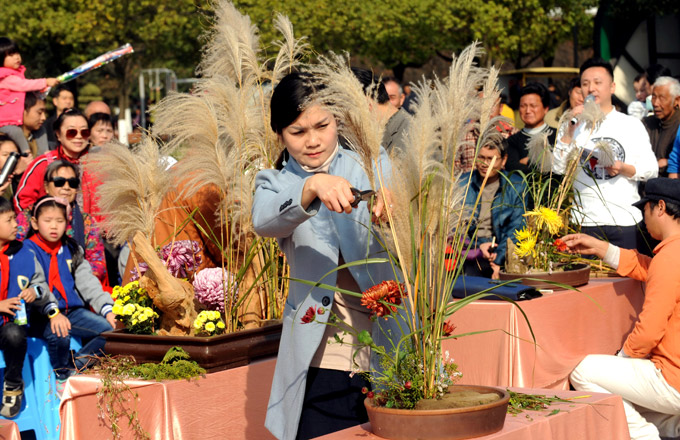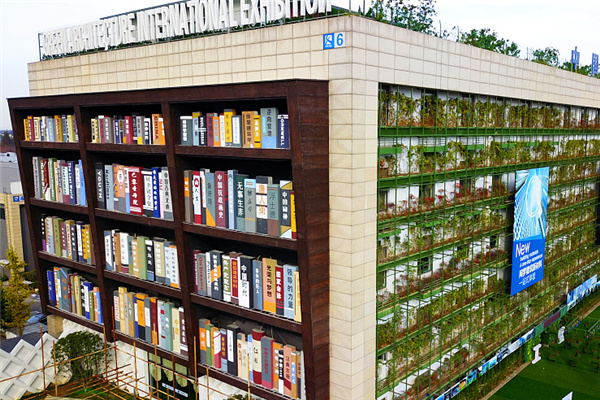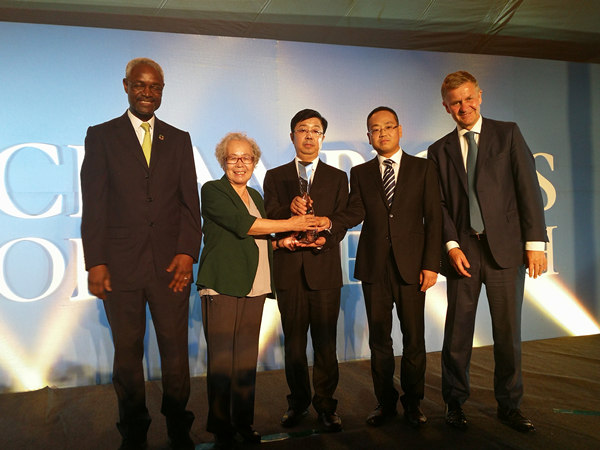

Chan Laiwa meets French |
Madam Chan, one of the wealthiest women in China, in fact was named the richest woman on the mainland by Forbes magazine. But the title she now prefers is curator of the China Red Sandalwood Museum.
The museum, on the north side of the metro line that serves the eastern suburb of Tongzhou, is an elegant, traditionally ornate structure. Inside is a collection of what might be the world's most precious red sandalwood sculpture and furniture.
The museum cost 200 million yuan to build, yet takes in only 10,000 yuan a month, barely enough to cover its utility bills. The operation employs 800 people, including a workshop that maintains, restores and manufactures fine red sandalwood works of art.
Madam Chan has spent 30 years, as well as some of her family fortune, to collect and make the pieces. But in recent years she has been selectively giving some of them away. One wonders why she would part with items that she holds so dear, and where the money came from for such a lavish pursuit, and indeed, why she developed such dedication.
Passion born in childhood
For Madam Chan, red sandalwood is not just a hobby, it is a passion.
Descendent from an aristocratic Manchu family, she developed her interest during early childhood when she would look at red sandalwood furnishings in her home and marvel at their exquisite beauty. The history of the pieces, the ornate engravings, the delicate texture, the fragrance of the wood, the elaborate craftsmanship, the auspicious meanings of carved motifs all would transfix her with awe and inspiration.
Red sandalwood is one of the most precious timbers on earth. It grows very slowly and is often hollow when mature. Hence the saying that "it grows an inch a century and an inch has the value of pure gold of similar size".
Yet, during the Cultural Revolution from 1966 to 1976 Chan watched as these treasures were discarded or destroyed. Her elder brother owned some fine furniture the legs were sawed off and burned, junked or smashed. Another relative sold his rare dressing table for 1.20 yuan because he feared persecution.
In that tumultuous era, owning something old could be construed as a crime, or at least a sign of not supporting the revolution.
When she stood in her house, emptied of these antique furnishings, she was engulfed by a sense of sadness and emptiness, as if the master of the house had left.
"After a hard day's work, you want to return to an environment of family warmth. But as these things were removed, I felt something missing, something dignified and representing the spirit of our culture was gone," Chan reminisces.
When the revolution drew to a close, Chan started to collect red sandalwood.
"Sometimes I located a good log. I would be so elated I'd forget who I was or where I was," she recalls.
Madam Chan's life philosophy is simple:
"When I have enough to eat and wear, I'm satisfied. I use my savings to restore and remake old furniture that was damaged at that time," she says. "I just love it. I want to see it in its old splendor. Piece by piece I make them, but I don't want to sell them off for profit. I want them to be my companions and witnesses to my life. You can call it arts and crafts collecting, but for me it is a passion."
Friendship breeds trust
Before her real estate business became so successful, she raised funds for furniture preservation and restoration with the help of her friends.
"My secret to success is to make a lot of friends. They come from all walks of life and each has his or her unique strength and wisdom," she says. "I'm very loyal to them, and the feeling is often mutual. I'm an ordinary person and cannot do everything by myself. But I'm also serious and never take things lightly."
When she was starting and needed financial support, her friends were there "through thick and thin", she recalls, and when she suffered setbacks, they would "pull me out of the quagmire".
Once she bought some sandalwood and boiled it in hot water, as suggested in a formula, but the information turned out to be wrong and it was ruined. Her friends came to her rescue and urged her to move on despite the setback.
"I have nothing but gratitude for them. They gave me money and said, 'If you turn a profit, give me my share, but if you fail, you can take as long as you like to pay me back'," she recalls. "Their generosity made me even more determined to pay back the loan, interest and all, and on time."
Friends have helped her, and she is ready to help them, too. She remembers an incident some 20 years ago when three friends in desperation turned to her. She not only loaned them 300,000 yuan, a sizeable sum at that time, which they needed for investing in a brewery, but also helped guide them to make rational decisions.
"When I do someone a favor, I don't expect something in return," she says. "But when someone does me a favor, I'm willing to repay twice as much."
She treats her employees the same way. "They are just like my family and see me as their mother. We share a table during meals and people are surprised that I don't act like a prissy boss," Madam Chan says.
She believes in equality and mutual respect in the workplace.
"If employees cannot work in harmony, the boss will have a hard time steering the ship. Working together gives us the opportunity to know each other and form a family environment."
Sharing Chinese heritage
In recent years, Madam Chan has handed over daily management to her son, concentrating instead on museum affairs. She wants to share her collection with the public, and more importantly, she wants the outside world to know more about Chinese culture through this unique art form.
So she embarked on a journey to donate some of her collection to foreign countries. A model of a sexangular pavilion that took 100 craftsmen over one year to finish was donated early this year to the Kyushu National Museum in Japan. The actual pavilion, located in the Forbidden Palace's Zhongshan Park, was originally designed by a Japanese architect.
Similar models of famous Beijing architecture have been donated to Beijing's Palace Museum, the Smithsonian Institute in the United States, the British Museum in London and the Dresden Museum in Germany.
Madam Chan also takes her collection on tours around the world, including to the National Museum of Women in the Arts in Washington DC. Several years ago, the Savannah College of Art and Design awarded her an honorary title of professor, recognizing her dedication to rescuing and reintroducing the cultural legacy of sandalwood carving.
"I'm grateful to their encouragement, which gives me confidence in what I do," says Chan.
Her collection was also prominently featured in the Aichi Expo in Japan in 2005, attracting 1.5 million visitors and a stream of media coverage.
Chan's latest donation is a one-fifth-sized replica of Beijing's Temple of Heaven, which took 100 artisans three years to carve, to the Chateau de Chambord in France. President Jacques Chirac and 200 dignitaries attended the ceremony, with accompanying pomp and protocol "fit for a queen", according to a report in the media.
The next recipient of her gift will be the United Nations.
"I'm giving part of my collection to other countries so that people there can better appreciate our culture," she explains
A member of the National Committee of the CPPCC, the advisory body to the central government, Madam Chan insists that "we should not lose our national legacy".
"It is our responsibility to maintain and promote our traditional culture, pass it to our children and let them know and be proud of it."
Chan Laiwa lives with her three children and grandchildren in a mammoth and stately building behind the museum. She is basking in the glow of her achievements and the warmth of her family. She loves her children and grandchildren, especially a two-year-old grandson.
"My son is attentive to detail, and his son is the same. It runs in the family," she laughs.
"My current husband and I have been married for 17 years. We love and respect each other. And we all live in a loving, caring environment," she says. "I'm contented."
(China Daily 04/23/2007 page12)













